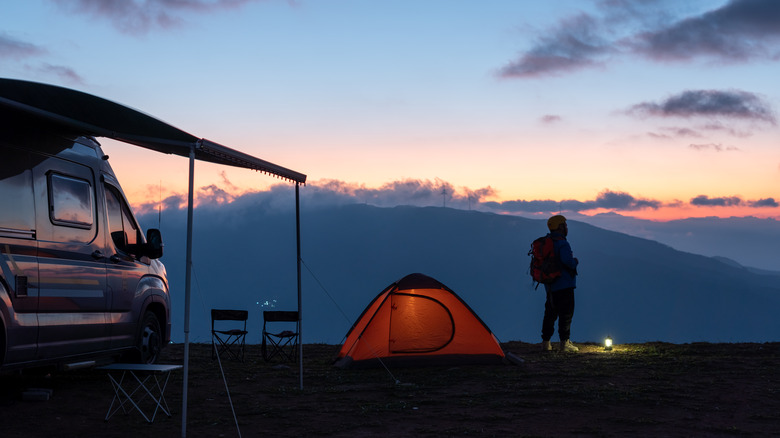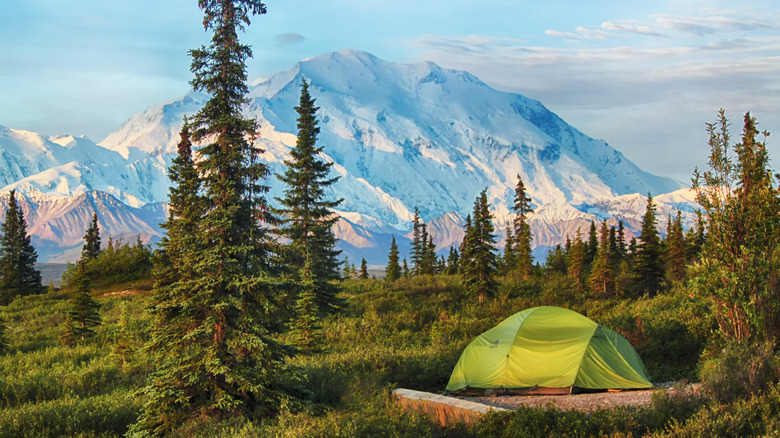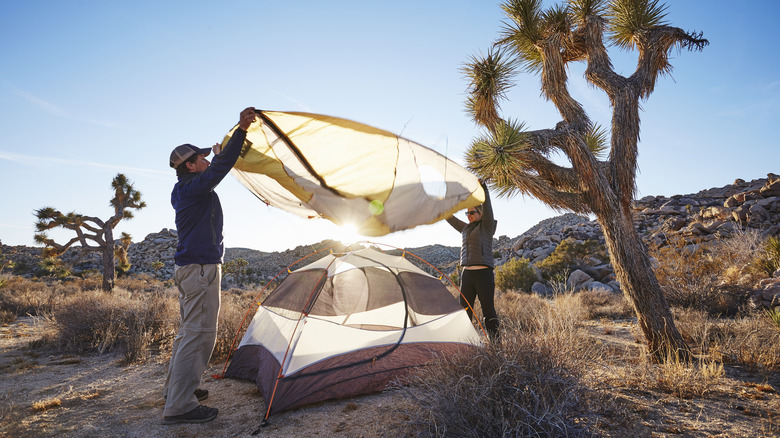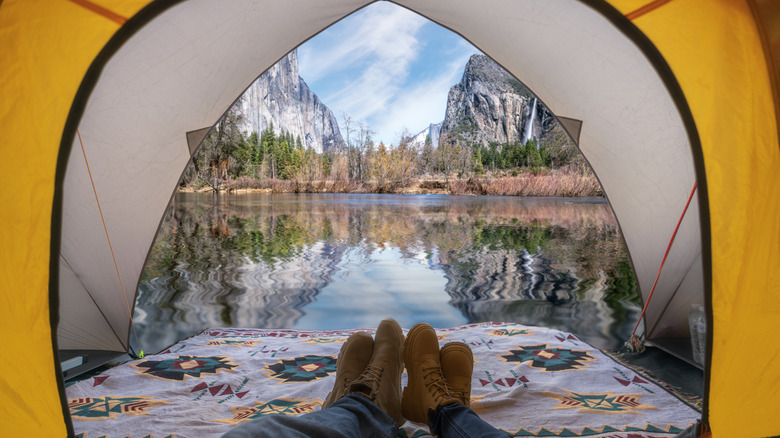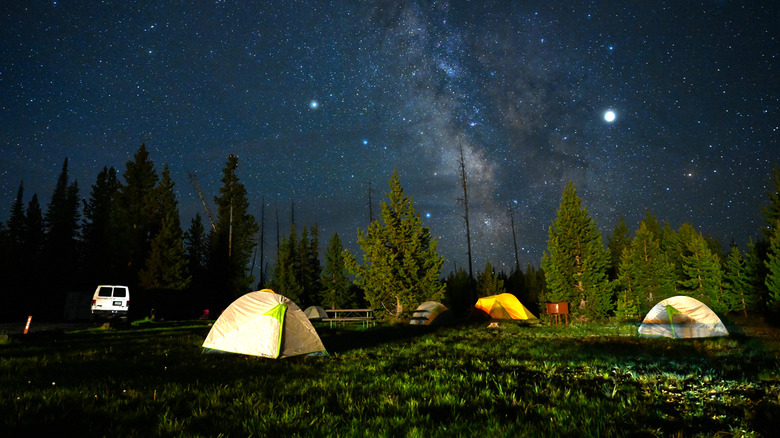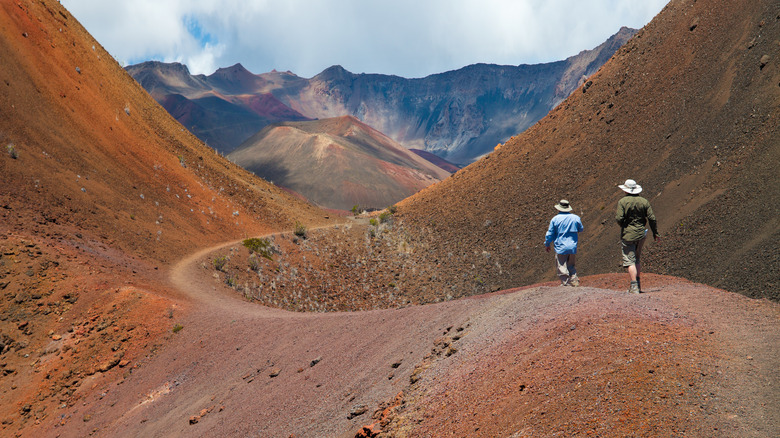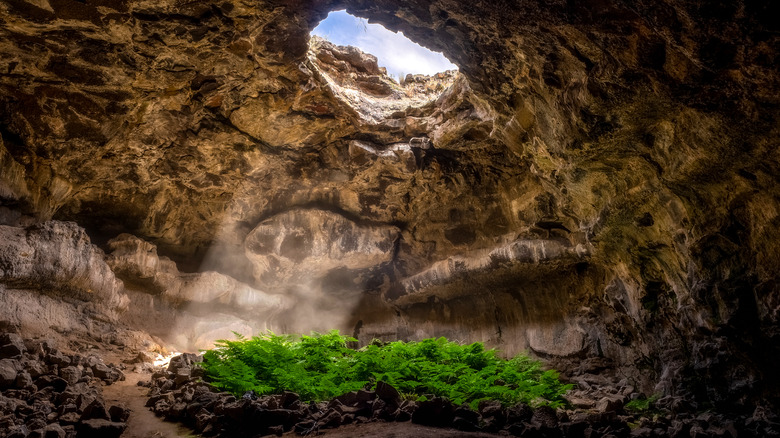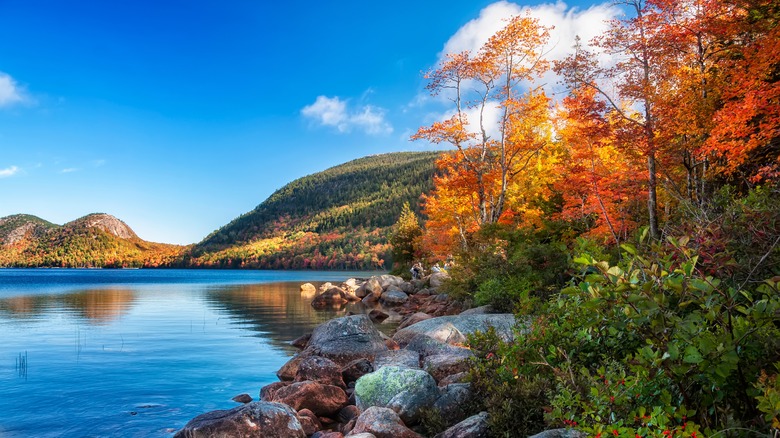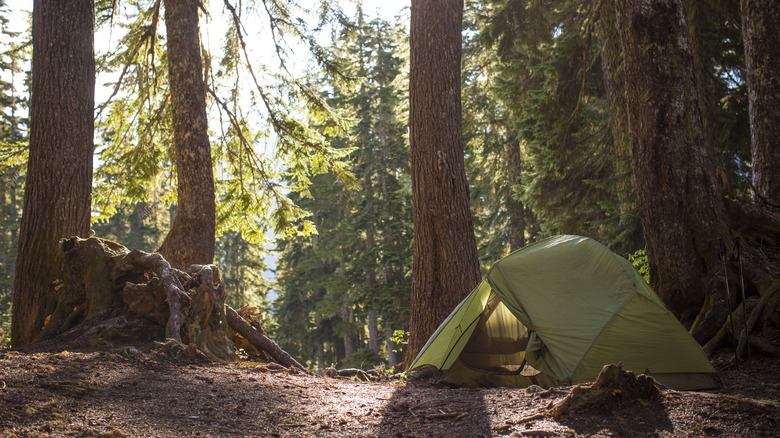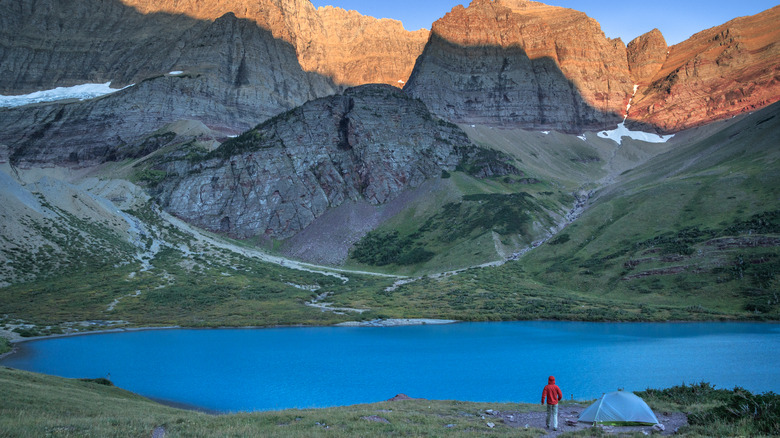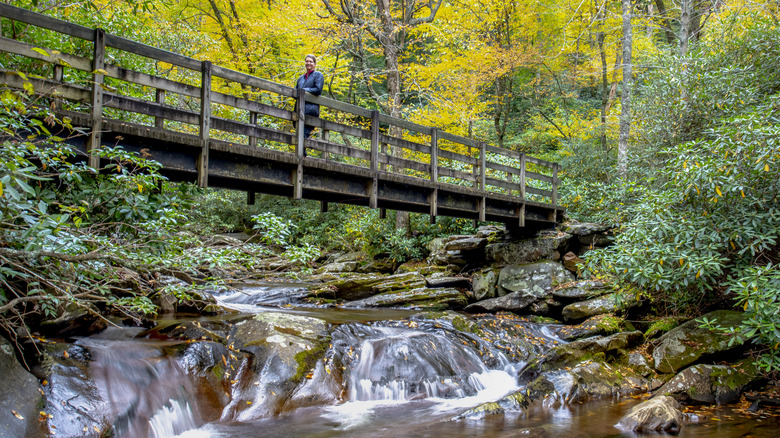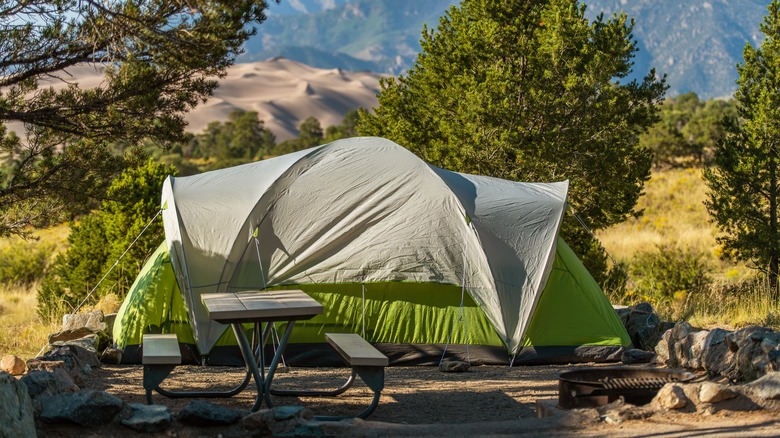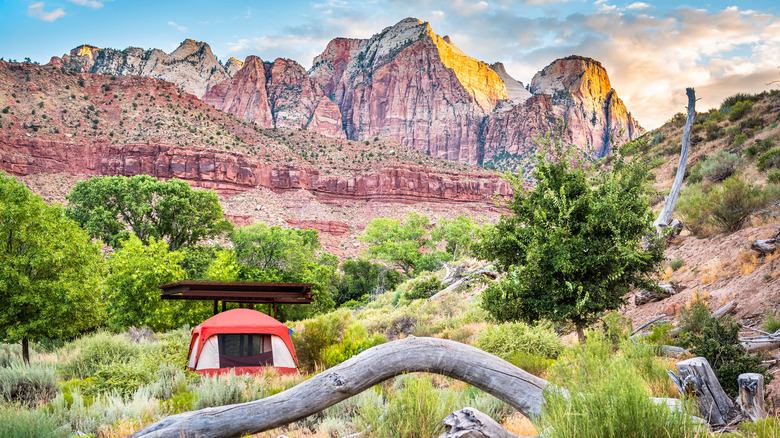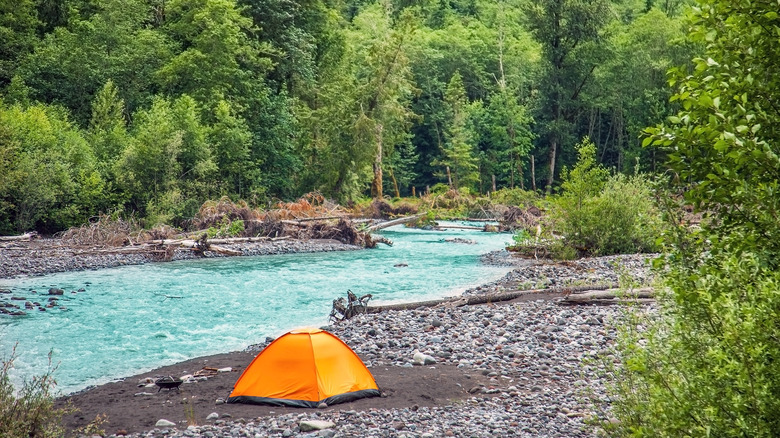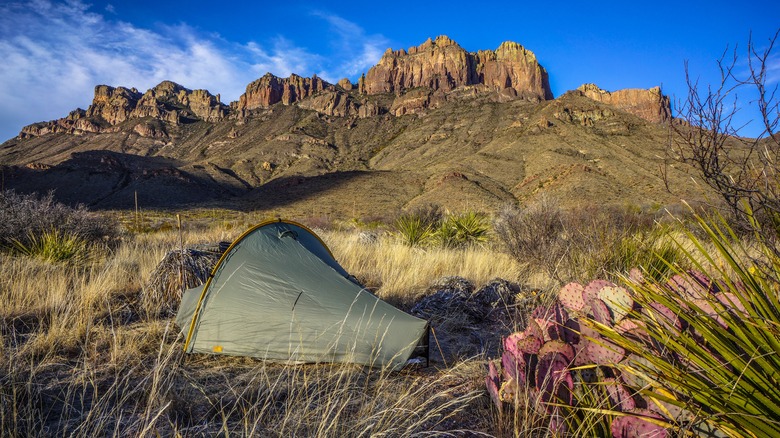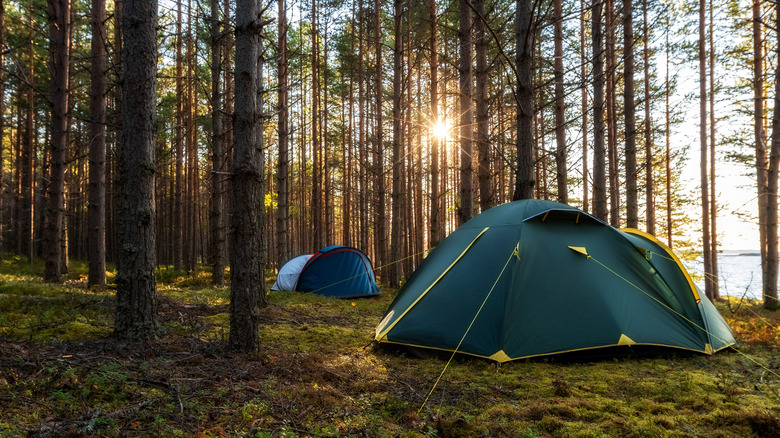These National Parks Are The Best For Camping In America, According To Campers
While some national parks can be experienced in one afternoon, others require several days to explore. The diversity of our parks is why some are more amenable to camping than others. Each of America's 63 national parks is unique and well worth a visit. However, several stand out from the pack for their exceptional camping options, sublime scenery, and memorable activities. That is why we have selected these national parks as the best for camping in America.
In general, there are a number of reasons why you should consider camping at our national parks. For one, pitching a tent is relatively cheap compared to booking a hotel room. If it's your first time camping, you can rent gear or invest in it for long-term use; to get started, check out these items for a quick and easy camping retreat. Then there's the fact that camping within the parks can help you beat the crowds. A third benefit of camping is that it enables kids to stay physically active, which is especially critical if they have been cooped up in a car all day. Finally, regardless of age, camping provides novel experiences that will keep your brain sharp and attentive.
In developing this guide, we drew from personal experiences and spoke to family and friends who are avid backpackers and car campers. We also consulted the National Parks Service website. More notes on methodology will be provided at the end of this article.
Denali National Park
Alaska has many nicknames, including "The last frontier," "Land of the midnight sun," and "Land of the noonday moon." We would expect no less from such a majestic state. Visiting Denali National Park offers an opportunity to explore a plethora of ecosystems, including meadows, taiga forests, scrub tundra, and impressive alpine peaks. If you were to stand at the top of the park's namesake, Mount Denali, you would be at a higher elevation than anyone else in North America (20,310 feet above sea level, to be precise). However, this is a climb reserved for serious mountaineers. There are plenty of accessible camping options closer to sea level for the everyday adventurer; just make sure you are prepared for the occasional grizzly bear sighting!
With mountains and rivers as your backdrop, you can claim a site in one of six campgrounds, all located along the park's singular meandering road. Since visitors cannot typically take personal vehicles beyond Mile 15, some campgrounds are only accessible by official park bus. However, you are exempted from the rule if staying at Teklanika River Campground at Mile 29 for three or more nights. Five campgrounds are only open during the summer for $25 to $49 per night, but if you don't mind some snow on your tent or windshield, you can camp for free at Riley Creek Campground during the winter. Ready to make a reservation? You can do so beginning December 1 of the year prior to your travels.
Joshua Tree National Park
This park may be named after a type of agave plant, but half the appeal of Joshua Tree National Park is in the rocks. Indeed, if you frequent your local bouldering gym or love to rock scramble, this is the park for you. Because of the rocks' proximity to the campsites, you can rock scramble whenever the urge strikes. However, with 300 miles of hiking trails around the park, your campsite may function more as a home base where you can return after a full day of exploring. If you aren't into hiking, there are also plenty of opportunities for biking, rock climbing, horseback riding, and birding. After expending all that energy, kicking back at your campsite to stargaze and view the Milky Way will be a rewarding treat.
There are 500 campsites at Joshua Tree. Most of these campsites can be reserved up to six months ahead of time, and they should be booked if you plan to camp on a weekend or a holiday or during springtime (October until May). Three campgrounds operate on a first-come, first-served basis. Amenities vary greatly, so read the details of each campground before making your reservation. If you miss out on claiming a site or want slightly more comfortable accommodations, consider staying at any of the glamping sites near Joshua Tree National Park.
Yosemite National Park
The cliffs, waterfalls, streams, and sequoias of Yosemite National Park were the muse of renowned photographer Ansel Adams, whose images have inspired generations of nature lovers to visit the park since the 1920s. Nestled in California's Sierra Nevada mountains, this park is biologically diverse and a mecca for hikers and rock climbers who flock to experience the magnificence of sites like Half Dome.
Yosemite is infamous for being one of the most crowded national parks in America. In fact, a reservation is frequently required to drive into or through the park during the busy summer months. That said, camping in the backcountry can take you away from the crowds, and the Hetch Hetchy section of the park can be particularly serene. After procuring a wilderness permit, you can camp at any of the Backpackers Campgrounds without a reservation.
If you prefer to car camp, know that reservations can be as difficult to obtain as tickets for a Taylor Swift concert. All campsites operate on a reservation system from April through October, with a lottery system in place for the popular North Pines Campground. To improve your chances of claiming a site, create and log into your recreation.gov account before 8 a.m. Pacific Time on the day you need to make a reservation. If you are visiting during the offseason, you may be able to snag a spot at one of the three first-come, first-served campgrounds.
Yellowstone National Park
Yellowstone can be overrun with visitors year-round, especially in the summer and around the more famous attractions like Old Faithful and Yellowstone Lake. So is the sightseeing worth the crowds? Absolutely. Chances are, you won't find any other destination with geothermal activity that matches that of Yellowstone National Park. Complemented by affordable, tranquil campsites amongst the mountains, you'll want to spend a night or two here to get the most out of your visit.
Mammoth Campground is the only campground that operates on a first-come, first-served basis, and that is only during the offseason, from October 15 until April 1. Otherwise, all campgrounds require reservations. Securing your spot early is recommended but not as essential as at Yosemite. Aside from amenities, consider what you want to do and see in the park when selecting a campground. For instance, Slough Creek Campground can put you in close proximity to wildlife, while Madison Campground is centrally located for geysers. Ready to plan your trip? Keep in mind these clever tricks for visiting Yellowstone National Park in the summer on a tight budget.
Haleakalā National Park
Haleakalā is a shield volcano with a crater that covers 75% of the island of Maui. With six major climate zones and a higher number of endangered species than you will find in any other American national park, you won't want to rush through your visit here. Not to be missed is the iconic sunrise experience at the 10,023-foot Haleakalā peak; note that you must make a reservation for your car in advance, which is easier said than done due to high demand.
There are car camping and tent camping options at Haleakalā National Park, as well as three wilderness cabins. If you are up for a more strenuous itinerary, plan on wilderness camping in the backcountry. Hiking down into the crater requires a fair amount of fitness, but the stunning, dramatic scenery will make you feel as if you are on another planet. Reservations can be made up to a month in advance for campsites and up to six months in advance for cabins. The maximum allowance for an overnight stay at Haleakalā National Park is 3 nights within 30 days. Read up on weather conditions and come well prepared, as forecasts can shift quickly.
Mammoth Cave National Park
This national park in Kentucky is underrated but full of interesting features: It has the longest cave system in the world (that we know of), as well as hiking trails, biking trails, canoeing and kayaking opportunities, fishing, and stargazing. As a UNESCO World Heritage Site and International Biosphere Reserve, camping at the park affords you plenty of time to sit still and observe the diverse species that call the area home.
If this is your first time camping or you prefer to stay at campgrounds with more amenities, Mammoth Cave has just what you need. The park offers three frontcountry campgrounds with amenities like toilets, showers, and full hookups (availability varies by campground). Mammoth Cave and Maple Springs Campgrounds are open from March 1 until November 30, while Houchin Ferry Campground is open year-round. In addition, there are 13 more remote backcountry options accessible by trail or river that are, for the most part, open year-round. You will need to obtain a permit no matter where you camp, and while you are at it, you might also want to reserve your campsite if you plan to visit on a holiday or weekend.
Acadia National Park
This national park is best known as the home to Cadillac Mountain, the first place from which you can see the sunrise in the United States from October 7 until March 6. However, there is so much more to explore in this culturally and biologically rich park. For instance, you can learn about the Wabanaki Nations, who have lived in the area now called Maine for 12,000 years, or you can head out on the park's 150-plus miles of trails. If someone in your party is a beginner, we suggest you try this Acadia National Park hike with mountain views. As you hike, watch out for peregrine falcons.
While backcountry and winter camping are not allowed at Acadia, there are four campgrounds open from May until October. A unique campground, Duck Harbor Campground, is accessible only by boat, and it affords campers plenty of privacy. There are only five campsites with a maximum allowance of six people per site. Make sure to read up on what you need for a solo camping trip before you go. You must make reservations up to two months in advance for all campsites.
Olympic National Park
Fans of Twilight know that this famous series was set in the dense, wet forests of Washington's Olympic Peninsula, and the mystical aura of this park will certainly have you looking over your shoulder for vampires and werewolves. Olympic National Park is a temperate rainforest covering almost 1 million acres. Whether you are a beach or a mountain lover, this park will send you home with many sweet memories. If you are visiting during the summer, savor the relatively cool temperatures on the peninsula, which can be a welcome respite from hotter locales, such as the nearby city of Seattle.
A wide range of campgrounds are located within Olympic National Park. If you don't mind the breeze, choosing a campground by the beach allows you to take long, relaxing walks along the Pacific Ocean. Alternatively, camp inland, where the towering Douglas firs, western hemlocks, and Sitka spruces, as well as bountiful bushes, moss-covered rocks, and vines, will shelter you in a cozy green cocoon. Campgrounds have varying amenities, and while some are first-come, first-served, others are available by reservation.
Glacier National Park
Glacier National Park is known for its majestic vistas, lakes, and glaciers. Whether you are in a car driving the 50-mile-long Going-to-the-Sun Road or in a pair of hiking boots traversing one of the park's 700 miles of trails, your jaw will surely drop at least a few times during your visit. Activities are available for adventurers of all skill levels. However, we recommend you avoid this trek if you're an inexperienced hiker. Instead, choose an easier yet still stunning hike like the McDonald Creek Trail. You can also bike, fish, join a boat tour, and (in the winter) cross-country ski.
Wilderness camping at Glacier National Park is a fantastic way to see nature in its full glory, but this style of camping is only recommended for those with plenty of experience. Otherwise, reserve a spot in one of the park's 13 frontcountry campgrounds, which offer varying amenities for your comfort. Note that most campgrounds take reservations (usually up to six months in advance), but some are first-come, first-served.
Great Smoky Mountains National Park
This park, located in the Appalachian mountains of Tennessee and North Carolina, was the most visited national park in America in 2023. It showcases southern Appalachia at its finest, with abundant waterfalls, gushing streams, forests, and historic buildings. Watching the park's synchronous fireflies between May and June may prove to be one of the most magical camping experiences of your life. There is also a good chance you'll see one of the park's estimated 1,500 black bears during your visit, not to mention deer, bats, groundhogs, salamanders, and squirrels.
There are backcountry, frontcountry, group, and horse campgrounds available at Great Smoky Mountains National Park. Of the 10 frontcountry campgrounds, 2 are open year-round. If you are camping during the summertime, expect hot and sweaty days unless you have chosen a site in Balsam Mountain Campground, which experiences cooler temperatures due to its elevation. You will need a reservation and permit if camping in the backcountry.
Great Sand Dunes National Park and Preserve
Did you know that you can sled without snow? Visit Great Sand Dunes National Park and Preserve in Colorado, and you'll be able to sandboard and sled to your heart's content. Blaze your own trails across the sand dunes, which span 30 square miles and are taller than any other sand dunes in North America. This park is more than one giant sandbox, however.
It is an International Dark Sky Park with phenomenal stargazing, which is reason enough to include camping in your itinerary. During your stay, you can also hike through forests, play in Medano Creek, and go on a horseback ride. Piñon Flats Campground is the only frontcountry campground at the park. It requires reservations and is open from April until October. Alternatively, you can hike to one of the backpacking campsites or stay at a campground nearby the park, some of which are open year-round.
Zion National Park
Located in Utah, Zion National Park features a gaping canyon that is contained by cliffs made of Navajo Sandstone. The park is famous for several of its incredible hiking trails, including Angels Landing, the Subway, and the Narrows. These trails are so popular that they require permits, which are difficult to obtain due to high demand. The striking rock faces that define the park are perfect for climbing, canyoneering, and biking, but birding, boating, stargazing, and horseback riding are also popular activities.
The park has three campgrounds, which are perpetually full from mid-March until late November. We recommend staying in Watchman Campground, which is highly rated and takes reservations up to six months in advance. Pack weather-appropriate clothing and gear, especially if you are visiting during the hot summer months; shade can be difficult to find.
Mount Rainier National Park
Mount Rainier is a glaciated mountain that is also an active volcano; while a significant eruption has not occurred for the last 500 to 600 years, the volcano nevertheless is a regular site of earthquakes and demonstrates considerable hydrothermal activity. Mount Rainier National Park also features over 29 major glaciers, many dazzling waterfalls, beautiful reflection lakes, and wildflowers. All these characteristics make it a compelling place to set up camp and explore.
There are three frontcountry campgrounds and one primitive campground at the park. The two largest frontcountry campgrounds, Cougar Rock and Ohanapecosh, take reservations. White River requires a permit but operates on a first-come, first-served basis. You also have the option to camp in the backcountry. Regardless of where you are staying, make sure you have a reservation to enter the park between the hours of 7 a.m. and 3 p.m.
Big Bend National Park
Last but not least, Big Bend is one of our favorite national parks on this list when it comes to camping. It is a Dark Sky Park famous for being one of the premier locations for stargazing in the United States. During the summer, when daytime temperatures exceed 100 degrees Fahrenheit, you might want to avoid the trails. If you are looking for indoor activities, we suggest learning about the park's geology, wildlife, and Native American culture at one of the visitor centers. You can also load up the car for a scenic drive; the park features over 250 miles of roads.
As for camping, there is an Aramark-operated full hookup RV campground and three other frontcountry campgrounds operated by the National Park Service. Consider the centrally located Chisos Basin Campground if you want to grill out, have access to fresh water and flush toilets, or need to use a generator. If you miss out on making a reservation, try staying at one of the campgrounds just outside the park. Backcountry camping is also available, so long as you have a permit.
Methodology
We developed this article based on personal experience. Additionally, we consulted avid camping friends and family and information provided on the National Parks Service website. We sought to represent a variety of camping styles and, therefore, did not favor campgrounds with creature-comfort amenities, given that many people prefer primitive sites. We also aimed to include geographical diversity and selected parks with different peak seasons so that no matter what time of the year you are traveling, you will have these tips readily available.
